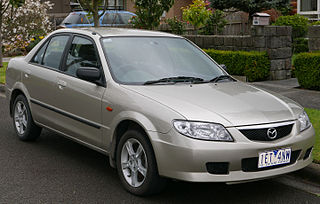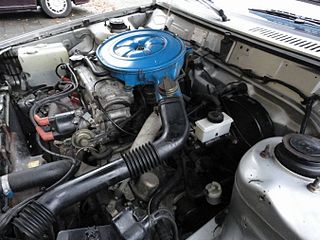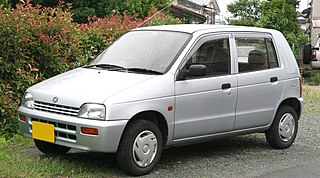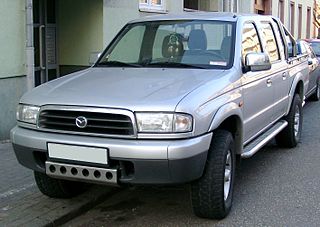Today, Mazda's kei cars use Suzuki engines, though the originals from the 1960s used a Mazda-designed OHV and two-stroke engines.[ citation needed ]
Today, Mazda's kei cars use Suzuki engines, though the originals from the 1960s used a Mazda-designed OHV and two-stroke engines.[ citation needed ]
The tiny 660 cc K6A was a Suzuki-designed and -produced inline-three, used in the (Suzuki-built) 1998 Mazda Carol. The turbocharged version produces 64 PS (47 kW; 63 hp) and 106 N⋅m (78 lb⋅ft), while the normally aspirated version is rated at 54 PS (40 kW; 53 hp) and 63 N⋅m (46 lb⋅ft).[ citation needed ]

The Ford Duratorq engine, commonly referred to as Duratorq, is the marketing name of a range of Ford diesel engines first introduced in 2000 for the Ford Mondeo range of cars. The larger capacity 5-cylinder units use the Power Stroke branding when installed in North American-market vehicles.

The Mazda Carol is a kei car manufactured by Mazda from 1962 until 1970. The Carol name was revived again with Mazda's 1989 re-entry into the kei car class with the Autozam brand. Since 1989, the Carol has been a rebadged model manufactured by Suzuki for Mazda, based on the Japanese Suzuki Alto. The first two generations of the modern era Carols received unique bodywork, but since late 1998 the nameplate has been strictly a badging exercise.

The Mazda Luce is an executive car that was produced by Mazda in Japan from 1966 until 1991. It was widely exported as the Mazda 929 from 1973 to 1991 as Mazda's largest sedan. Later generations were installed with luxury items and interiors as the Luce became the flagship offering. The Luce was replaced by the Sentia in 1991 which was also exported under the 929 nameplate.

The Mazda Familia, also marketed prominently as the Mazda 323, Mazda Protegé and Mazda Allegro, is a small family car that was manufactured by Mazda between 1963 and 2003. The Familia line was replaced by the Mazda3/Axela for 2004.
The Jaguar AJ-V6 engine is a piston engine based on the Ford Duratec V6 engine. The Duratec V6 was originally a Porsche design, purchased by the Ford Motor Company with Cosworth finishing the engineering to suit Ford's needs. One notable addition is the use of variable valve timing, a feature also shared with Mazda's version of the engine. It is available in 2.1 L (2,099 cc), 2.5 L (2,495 cc) and 3.0 L (2,967 cc) displacements.

The Ford Cologne V6 is a series of 60° cast iron block V6 engines produced by the Ford Motor Company from 1962 to 2011 in displacements between 1.8 L; 110.6 cu in (1,812 cc) and 4.0 L; 244.6 cu in (4,009 cc). Originally, the Cologne V6 was installed in vehicles intended for Germany and Continental Europe, while the unrelated British Essex V6 was used in cars for the British market. Later, the Cologne V6 largely replaced the Essex V6 for British-market vehicles. These engines were also used in the United States, especially in compact trucks.

The F engine family from Mazda is a mid-sized inline-four piston engine with iron block, alloy head and belt-driven SOHC and DOHC configurations. Introduced in 1983 as the 1.6-litre F6, this engine was found in the Mazda B-Series truck and Mazda G platform models such as Mazda 626/Capella as well as many other models internationally including Mazda Bongo and Ford Freda clone, Mazda B-series based Ford Courier, Mazda 929 HC and the GD platform-based Ford Probe
The Mazda B-series is a small-sized, iron-block, inline four-cylinder engine with belt-driven SOHC and DOHC valvetrain ranging in displacement from 1.1 to 1.8 litres. It was used in a wide variety of applications, from front-wheel drive economy vehicles to the turbocharged full-time 4WD 323 GTX and rear-wheel drive Miata.
After an early flirtation with V-twin engines, Mazda's small cars of the 1960s were powered by OHV straight-2 and straight-4 engines. This family lasted from 1961 until the mid-1970s. Today, Mazda's keicars use Suzuki engines. It was produced at the Hiroshima Plant in Hiroshima, Japan.

Mazda has a long history of building its own diesel engines, with the exception of a few units that were built under license.

The Suzuki Alto is a kei car produced by Suzuki since 1979. The model, currently in its ninth generation, was first introduced in 1979 and has been built in many countries worldwide. The Alto originated as a commercial vehicle derivative of the Fronte, but over time the Alto nameplate gained in popularity and by 1988 it replaced the Fronte name completely. The Alto badge has often been used on different cars in Japan and in export markets, where it is considered a city car.
The Nissan H series of automobile engines is an evolution of the Nissan "R" engine which was based on the 1.5-liter, three-main bearing "G" engine used in the 1960s. Both inline-four and inline-six versions were produced. It is a pushrod OHV design with iron block, early models with an iron head, later models with aluminum head. Versions of this motor have been used in many Nissan autos and forklifts, well into the eighties and a version called H20II was in production until 2003. The SD diesels are based on this series of motors

The Prince G-series engine was the company's only straight-four and straight-six engines which began production in 1955. A number of variations were made, with both OHV and OHC heads. A diesel four-cylinder with 1.9 L (1,862 cc) was also built, called the D-6. The G series was used in the Skyline, the Laurel, and the Gloria from the 1950s to the early 1970s.

The Mazda B series is a series of pickup trucks that was manufactured by Mazda. Produced across five generations from 1961 to 2006, the model line began life primarily as a commercial vehicle, slotted above a kei truck in size. Through its production, Mazda used engine displacement to determine model designations; a B1500 was fitted with a 1.5 L engine and a B2600, a 2.6 L engine.

The Ford Duratec V6, is an aluminum DOHC V6 engine with a 60° bank angle introduced in 1993 with the Ford Mondeo. The primary engineering input came from Porsche, who was developing a similar V6 before selling the engineering to Ford, and Cosworth, who helped with cylinder head manufacturing. The Jaguar AJ-V6 engine is similar but adds variable valve timing.

The DLD is the name for an automobile engine family – a group of compact inline-four Diesel engines, involving development by Ford of Britain and/or PSA Group, and also Mazda where it is called the MZ-CD or CiTD. The Ford of Britain/PSA and joint-venture for the production of the DLD/DV was announced in September 1998. Half of the total engine count are produced at Ford of Britain's main plant at Dagenham, England and at Ford's Chennai plant in India, the other half at PSA's Trémery plant in France.

The H family is a line of automobile 60° V6 engines from Suzuki. Ranging in displacement from 2.0 to 2.7 L, the H family was a modern all-aluminum engine with dual overhead cams, 24 valves, and direct fuel injection. It was co-developed with Mazda and Toyota, which used a similar design in their 2.0 L KF V6 and the Toyota VZ engine. The H family was introduced in 1994 with the H20, but Suzuki, Toyota and Mazda's designs diverged greatly with the former increasing displacement and the latter experimenting with alternative induction technologies and smaller engine sizes.

The Mazda L-series is a mid-sized inline 4-cylinder gasoline piston engine designed by Mazda as part of their MZR family, ranging in displacement from 1.8 to 2.5 liters. Introduced in 2001, it is the evolution of the cast-iron block F-engine. It was co-developed with Ford, who owned a controlling stake in Mazda at the time. Ford uses it as their 1.8 L to 2.5 L Duratec world engine and holds a license to develop engines based off the L-series in perpetuity.

The Suzuki F engine is a series of inline three- and four-cylinder internal combustion petrol engines manufactured by Suzuki Motor Corporation and also licensed by many manufacturers for their automobiles. This engine was Suzuki's first four-stroke car engine when it first appeared in 1977.

The Suzuki K engine family is a series of automobile engines from Suzuki, introduced in 1994. Displacements range from 0.7 L to 1.5 L. All engines have aluminium cylinder blocks with three or four cylinders in-line. Cylinder heads have two overhead camshafts, driven by chain, and four valves per cylinder. Fuel is gasoline/petrol, metered by multipoint fuel injection or direct injection. Some variants are turbocharged.